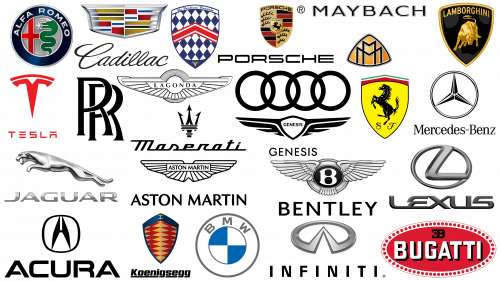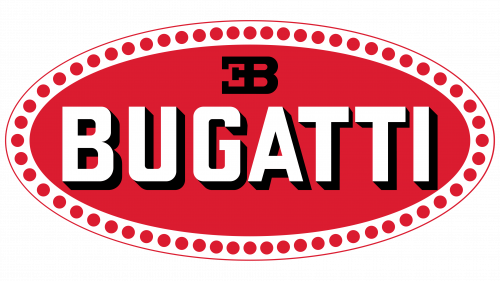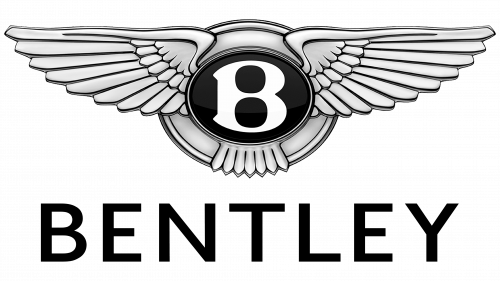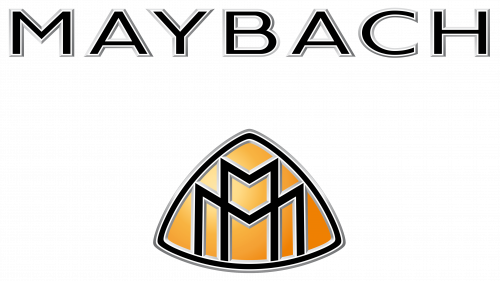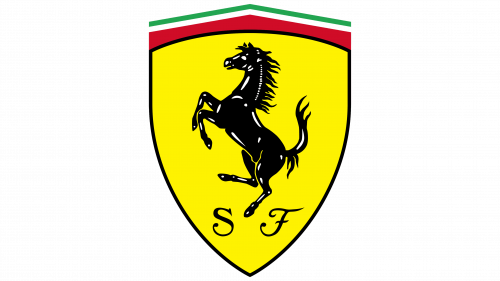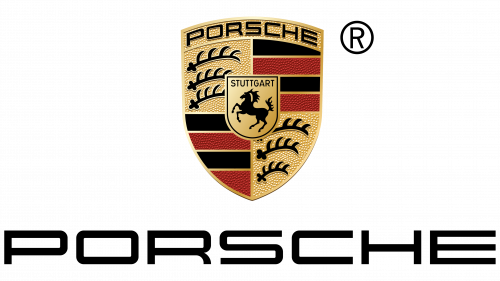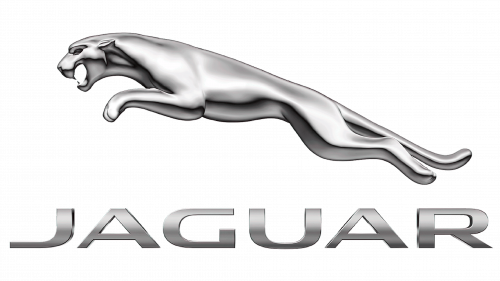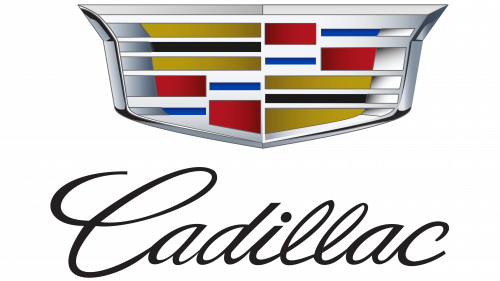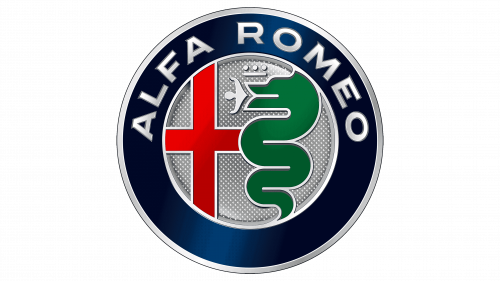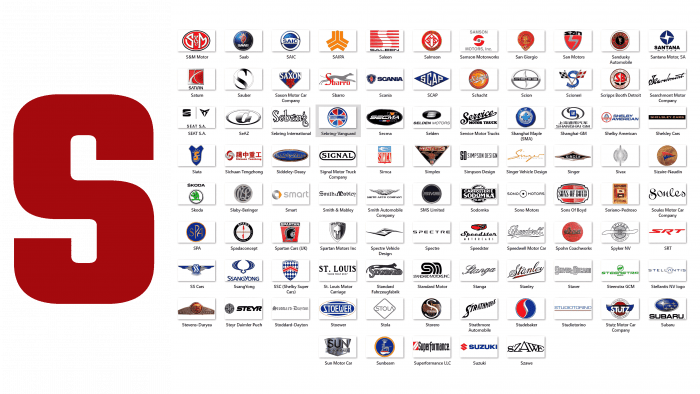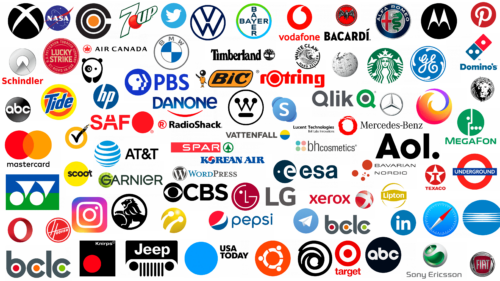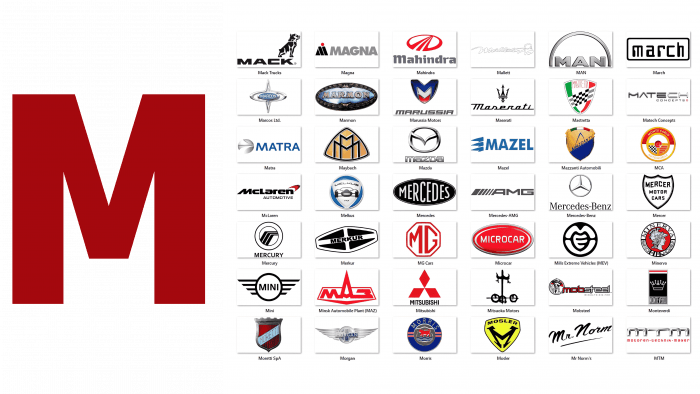Prestige automobile emblems are not just a visual representation of high-end car brands. They have become coveted symbols of luxury and status and are deeply admired by a wide range of car enthusiasts. Owning a car adorned with one of these symbolic insignia evokes a sense of deep pride.
Even those who are not fortunate enough to own an expensive car are likely to recognize a few of the iconic symbols. Whether it’s Bentley’s majestic wings or the famous double R associated with Rolls Royce, these emblems are firmly embedded in people’s minds. And while each has its own design, all these logos strive to embody an aura of exclusivity and luxury.
We take a look at some of the most famous luxury car emblems that have left an indelible mark over time and shed light on the complex subjects and inspirations behind their designs.
The most famous luxury car logos
A panorama of designs and classifications opens up when you get to know premium cars. On one hand, brands such as Bentley and Maybach epitomize luxury and sophistication. These brands uphold the ideals of craftsmanship, refinement, and incorporation of the latest technological advances. Their cars often serve as models of luxury, combining unrivaled comfort and unique aesthetic appeal.
At the other end of the spectrum, brands such as Porsche and Ferrari stand out, representing a fusion of luxury with high-octane performance. These names have become synonymous with speed, agility, and engineering prowess. Despite the luxury, their appeal lies in their ability to deliver an exhilarating driving experience. The design, aerodynamics, and engineering of these brands reflect a relentless pursuit of excellence and performance.
In the broader context of the automotive industry, these brands demonstrate the variety and depth of options available to consumers seeking luxury and performance. While Bentley and Maybach target those who appreciate the finer aspects of automotive elegance, Porsche and Ferrari appeal to those who enjoy driving dynamics and engineering marvels.
The automotive world offers many exceptional cars, each with its own distinctive features. Whether it is the elegance of a Bentley, the regal presence of a Maybach, the dizzying speed of a Ferrari, or the dynamism of a Porsche, each brand has carved a niche for itself, leaving an indelible mark on history.
Rolls-Royce
Known as the beacon of British automotive luxury, Rolls Royce has written its name in the annals of global automotive history. Born in 1904, this iconic automotive brand has wasted no time in cementing its status by creating engines that are unparalleled in their excellence.
The Rolls Royce emblem, with its intricate crossed R pattern, pays homage to the brand’s founder, Henry Royce. The emblem, in an exquisite serif font, speaks to the brand’s professionalism and hints at its rich pedigree and heritage. According to some industry insiders, the intertwined R’s subtly reflect the brand’s deep connection with its loyal customers, symbolizing unity and mutual admiration.
The monochromatic black and silver palette further emphasizes the brand’s commitment to elegance and timeless grace. In their simplicity, these colors exude a sense of regal luxury, making them appropriate for a brand that stands for unsurpassed luxury and timeless design.
Bugatti
Bugatti is globally recognized for creating high-performance cars, the history of which began in 1909. In more than a century of Bugatti’s history in the automotive field, many outstanding models have been created. Among them are the Type 41 Royale and the Type 55 sports car, which exemplify the brand’s commitment to engineering and design excellence.
The Bugatti emblem is a tribute to the company’s deep history and design. The emblem is framed by red studs that resemble gemstones. These studs often draw parallels with rubies – precious stones known for their brilliance and luxury. Such symbolism is quite appropriate, given that the foundation of the company was laid by the offspring of a jeweler.
The center of the emblem is dominated by an intense red color, radiating passion and fervor – traits synonymous with the Bugatti brand. Above this vibrant background rises the symbolic “EB” logo, elegantly positioned at the peak of the design. These initials are a tribute to Ettore Bugatti, the innovator who breathed life into the brand. The subtle detailing and rich symbolism of the emblem embody the brand’s commitment to elegance, luxury, and the highest automotive craftsmanship.
Bentley
Bentley, a prominent British automaker, has carved a niche for itself in the production of luxury cars. Recognized for its exquisite cars and SUVs, the brand epitomizes British luxury and craftsmanship.
Founded in January 1919, Bentley has undergone many transformations. Now, under the auspices of the Volkswagen Group, the brand continues to preserve its heritage by creating premium cars that are elegant and dynamic.
Delving deep into the Bentley emblem, one cannot help but notice its symbolism. The wings integrated into its design are more than just decorative elements. They reflect the themes of speed, freedom, and ambition that resonate deeply with car enthusiasts. These wings recall Bentley’s early beginnings in aviation, reinforcing the brand’s association with speed and innovation.
The Bentley logo, often rendered in monochromatic black and white or black and silver tones, is a beacon of luxury. Such color schemes underscore the brand’s commitment to timeless elegance and its unique position in the automotive industry. Bentley cars and the emblematic logo demonstrate the intersection of tradition, innovation, and unrivaled luxury.
Maybach
Maybach, hailing from Germany, is a testament to the pinnacle of automotive excellence. It certainly occupies a significant place in the pantheon of luxury automobiles.
An integral part of the esteemed Mercedes-Benz family, Maybach traces its history back to 1909. This rich history underscores its commitment to impeccable design and performance. The brand is inextricably linked to its founder, Wilhelm Maybach, who laid the foundations for what has since become a symbol of luxury and precision in the automotive industry.
The Maybach logo embodies the essence of the brand. The double monogram “M,” standing for “Maybach Motorenbau,” is elegant and assertive.
The emblem’s color palette of gold, black, and yellow emphasizes its grandeur. In combination with the striking design, these colors create an impression of exclusivity, setting Maybach apart from other luxury cars. More than just a branding tool, the emblem represents the brand’s rich heritage and its commitment to excellence in automotive design and engineering.
Koenigsegg
Koenigsegg, a Swedish marvel, is characterized by its commitment to building high-performance sports cars. Beginning its journey in 1994, the brand was conceived with a single ambition: to create a sports car that meets the world’s standards of excellence.
Through rigorous research, development, and a relentless pursuit of innovation, Koenigsegg introduced the CC8S to the world. This car was a testament to the brand’s engineering prowess and cemented its status as one of Sweden’s most famous automotive masterpieces.
The emphasis on aesthetics is not limited to the brand’s cars. The Koenigsegg emblem is a story deeply rooted in history and heritage. The shield that dominates the emblem is inspired by the Koenigsegg family’s ancestral coat of arms. As a subtle hint of the country’s heritage, the emblem also pays homage to the Swedish Air Force Squadron, emphasizing the brand’s reverence for its roots.
The harmonious combination of deep blue, rich red, bold black, and luxurious gold further emphasizes the emblem’s luxurious essence. Each carefully chosen shade enhances the grandeur of the emblem, making it an unmistakable symbol in the echelon of luxury automobile brands.
Lamborghini
The Lamborghini emblem, depicting a majestic golden bull, is instantly recognizable around the world. Originating in Italy in 1963, Lamborghini has consistently set the benchmark for luxury cars. Despite operating under the larger umbrellas of Audi and Volkswagen Group, the company’s identity remains unchanged.
There is a noticeable trend in the automotive sector to use animal-like symbols to express brand ethics. For Lamborghini, the choice of the bull is far from accidental. It represents power, meticulous craftsmanship, and an aura of dominance – qualities synonymous with the cars created by the company.
Often associated with tenacity and unstoppable strength, the bull reflects the brand’s relentless pursuit of excellence. The use of a golden hue to represent the bull emphasizes these qualities and demonstrates the brand’s luxurious stance.
Further emphasizing its quest for greatness, the Lamborghini logo uses a combination of black and gold colors. The stark contrast between the two hues evokes a sense of prestige and effectively conveys the brand’s commitment to unrivaled luxury and elegance in the automotive world.
Ferrari
The Ferrari emblem depicting the legendary galloping horse has become synonymous with speed, luxury, and elite craftsmanship. The Ferrari emblem appeared in 1939 under the leadership of Enzo Ferrari, but it was not until 1947 that it began to adorn the company’s cars. Already in the early stages of its existence, Ferrari stood out among other brands.
The bright yellow background of the emblem not only makes it stand out against the background of the horse, which seems ready for action but also creates a vivid contrast. This symbol was not just an artistic choice. According to legend, the galloping horse was adopted as an emblem of good luck for the brand.
The green, red, and white stripes on the emblem point to Ferrari’s Italian pedigree, subtly reminding the observer of the brand’s rich heritage in the heart of Italy.
The emblem’s origin story adds another layer of intrigue. It is believed that the choice of the “galloping horse” was inspired by an image that Enzo Ferrari noticed on the fuselage of an airplane piloted by Francesco Baracca during the First World War. This historical connection gives the emblem a sense of heritage and reverence, linking the luxury car brand to a rich past.
Aston Martin
Loyal fans of British luxury cars will undoubtedly recognize the Aston Martin emblem. Founded in 1913, Aston Martin quickly gained a reputation for producing cars that epitomized luxury and superior class. In addition to material products, the brand has been immortalized in pop culture, notably appearing repeatedly in James Bond movies and literature.
Aston Martin sports cars are not just vehicles but a reflection of British heritage, embodying the best elements of luxury automobile design. The brand’s winged emblem is a vivid embodiment of its core values and aspirations. These elegantly spread wings reflect feelings of freedom, adventurism, and impetuosity.
Shades of green adorn the Aston Martin emblem, paying tribute to the racing heritage and national pride. In modern times, the brand is leaning towards a silver palette for its logo. This hue emphasizes its sophisticated aura, combining the brand’s rich history with a modern luxury aesthetic.
Maserati
The Maserati logo is an iconic image of the luxury automaker. Its history dates back to 1914, and Maserati’s heritage spans more than a century. Maserati was originally associated with the famous Ferrari brand but later became part of the Stellantis conglomerate.
Throughout its illustrious history, Maserati has produced many famous cars that have gained attention and admiration all over the world. The emblem, inspired by Bologna’s Piazza Maggiore, takes its name from the magnificent trident of Neptune, symbolizing dominance and vigor. It is these connotations of power and dynamism that are embedded in the Maserati emblem.
The emblem embodies elegance and charm, reflecting the brand’s commitment to excellence and luxury in automobile design, and is presented in a monochromatic black and white palette combined with a serif font underneath.
Porsche
Porsche has become an iconic name in the world of luxury automobiles. Founded in 1931, the brand has become synonymous with superior engineering and design, producing high-performance sedans, SUVs, and sports cars in demand around the world.
The deep essence of the Porsche brand is evident in its vehicles and is reflected in its emblem. The emblem is a tribute to the free nation-state of Württemberg. This geographical connection is further emphasized by the inclusion of a crest-shaped coat of arms in the emblem. This design choice is not only aesthetically pleasing but also demonstrates the brand’s deep respect for its history and origins. The coat of arms of Stuttgart is placed within the crest, emphasizing the importance of this city in the formation and development of Porsche.
The color palette of the emblem plays an important role in conveying the philosophy and vision of the brand. The golden color symbolizes the brand’s commitment to quality and excellence. The refined black color denotes the strength and elegance that Porsche cars undoubtedly possess. Vivid red reflects the passion and vigor that drives the company’s innovation. Together, these elements tell a story of luxury, history, and unrivaled craftsmanship embodied in Porsche.
Lagonda
Originally from the British Isles, Lagonda is a shining beacon in luxury car manufacturing. Part of the esteemed Aston Martin group, the brand was founded in 1906. Over the decades, it has given the world cars that belong to the vintage and retro design eras and exude modern luxury and sophistication.
If you delve into the Lagonda emblem, it is evident that the brand seeks to embody the spirit of freedom and the pursuit of excellence. The winged motif, which has become iconic in the automotive sphere, conjures up the image of a majestic bird in full flight. The wings spread out, testifying to strength and majesty, rising proudly above the brand name.
The harmonious combination of black and silver defines the color scheme of the logo. These shades are a classic choice for luxury symbols; they carry sophistication and eternal charm. The wordmark uses a unique stylization of the letter “A.” This letter is brought to life by the pronounced shape of the letter “V” crossing its middle, bringing an element of distinction to the overall design. All of these elements combine to create a logo that both reflects the brand’s heritage and demonstrates its commitment to the highest level of automotive excellence.
Tesla
Tesla, which has become a beacon in the luxury car industry, has quickly established a dominant position, especially in the electric vehicle sector. Although the company was founded in 2003, making it a relatively new entrant in the automotive annals, its influence and scope of operations surpass that of its longtime peers.
What sets Tesla apart in the automotive field is its commitment to combining luxury with green technology. This commitment is evident not only in the company’s cars but also in its corporate identity. Despite the apparent simplicity of the image of the letter “T,” the Tesla emblem carries a deeper meaning. The emblem represents a cross-section of an electric motor, drawing inspiration from the innovative designs of legendary inventor Nikola Tesla. This strategic design choice not only emphasizes the brand’s name and commitment to electric vehicle technology but also pays homage to the pioneer in the field of electrical engineering.
This thoughtful integration of design and storytelling makes the Tesla logo not just a symbol but an affirmation of the brand’s commitment to revolutionizing the automotive industry.
Mercedes-Benz
Originating from Germany, the word “Mercedes” means “Happy” in English. This name makes it clear what the brand is striving for to usher in an era of transformation for car enthusiasts around the world. Since its founding in 1926, Mercedes-Benz has cemented its reputation as a beacon of luxury and the highest level of automotive excellence.
In addition to its famous luxury cars, Mercedes-Benz has demonstrated its versatility by introducing a range of commercial vehicles that combine affordability with the quality inherent in the brand. A distinctive feature of the brand is the emblematic three-pointed star. This trio of dots represents Mercedes-Benz’s mission of comprehensive motorization.
The triad carries an additional meaning, symbolizing the company’s desire to leave an indelible mark in three spheres: at sea, in the sky, and on land. This multifaceted symbolism emphasizes the brand’s forward-thinking vision and commitment to industry dominance.
The black and silver color scheme of the logo speaks volumes. These hues, which exude elegance and refined taste, are also in line with the brand’s ethos of combining understated grace with innovative design. This hallmark sets Mercedes-Benz apart in the world of luxury car brands.
BMW
Synonymous with automotive luxury and precision, BMW has firmly established its place in the global automotive sector by offering a combination of performance, innovation, and elegance. While BMW car prices may not reach the zenith of luxury like other brands, they are certainly designed for those who seek class and sophistication.
Founded in 1916, BMW has since evolved and expanded its presence around the world. Today, the brand is not limited to manufacturing cars but has diversified into different segments of the automotive industry, reaching out to audiences with different tastes and preferences.
The BMW emblem is a testament to its rich Bavarian pedigree. The emblem, designed in the distinctive colors of the Bavarian flag but upside down, testifies to the brand’s deep roots in this region of Germany. This design choice is a conscious effort to emphasize and celebrate the company’s historical past.
The central part of the emblem has an intriguing interpretation. It resembles a rotating helicopter propeller, symbolizing movement, progress, and the brand’s first steps in aviation.
Through its cars and emblem, BMW speaks of German engineering excellence, a commitment to innovation, and a deep respect for its heritage.
Lexus
Emerging from the heart of Japan, Lexus is a symbol of luxury in the automotive sector. Since its inception in 1989, the brand has successfully expanded its presence, serving discerning customers in more than 90 countries around the world. Recognizing its high standing and unmatched value, Lexus is proud to claim its position among the leading Japanese brands with an impressive valuation in the global market.
The Lexus emblem is characterized by a thoughtful design that goes beyond its initial simplicity. The shape of the emblem, reminiscent of the graceful arc of a roadway or an arrow in flight, epitomizes the dynamic movement of Lexus vehicles and streamlined design features. This subtle hint of aerodynamics emphasizes the brand’s commitment to performance and innovation.
The emblem is dominated by an elaborate “L” in luxurious silver tones. This choice gives the emblem an element of luxury and reflects an ethic of refinement and excellence. The emblem serves as a testament to Lexus’ continued commitment to design and engineering excellence.
Audi
Founded in Germany, Audi is one of the most renowned luxury car manufacturers and is part of the esteemed Volkswagen Group. If you trace the history of this iconic brand, you’ll find a string of complex corporate mergers. Initially, four different businesses came together, intertwined their legacies, and created what is now the universally recognized name of Audi.
The intriguing aspect of the brand is its terminology. The word “Audi” is derived from Latin. This choice was influenced by the surname of one of the company’s founders, August Horch. From German, “Horch” translates as “listen,” which in Latin turns into “Audi.”
As for the emblem that adorns every Audi car, it is a testament to the company’s history. The quartet of intertwined rings that form the emblem symbolizes the four car companies that came together to create Auto Union, which later evolved into the modern Audi. For all its simplicity, this emblem left its mark on the world stage, instantly becoming a symbol of luxury and German engineering excellence.
Jaguar
Jaguar’s symbolic depiction of Jaguar in its emblem serves as a vivid reminder of the power of animal imagery in automotive branding. Founded in 1935, Jaguar, Britain’s preeminent automotive giant, has left an indelible mark in the annals of automotive history.
The emblem, depicting a leaping cat, clearly demonstrates the brand’s commitment to dynamism and impetuosity. This image not only emphasizes the concepts of impetuosity and courage but also reflects the features of the most majestic animal. Such characteristics are a perfect fit for a company whose foundation is the creation of vehicles that focus on both performance and grace.
A common theme among the elite of the automotive industry is the preference for certain colors in branding, and for Jaguar, the choice of silver is particularly relevant. This hue emphasizes the aristocratic nature of the brand and gives it a consistent touch of class and sophistication.
Cadillac
Originating in 1902, Cadillac, a major division of the venerable GM company, has earned a reputation as a manufacturer and marketer of high-end automobiles. Its international presence is impressive, with Cadillac models on the roads of 34 countries.
Cadillac proudly holds a beacon position in the United States luxury car sector, often considered the pinnacle of luxury and engineering excellence.
The origin of the Cadillac emblem is linked to an interesting historical figure, a French adventurer named Antoine de la Mothe. Some speculate that Antoine may have traced his lineage back to Cadillac’s founder, visionary Henry Leland. This connection led to an emblem with a rich pedigree and meaning.
The emblem has undergone various refinements to reflect the changing aesthetics of the times. It has a modern metallic finish that combines the brand’s historic past with its aspirations for the future.
The rich palette of red, gold, blue, and silver hues symbolizes the brand’s commitment to luxury, elegance, and unsurpassed craftsmanship. Every nuance of the emblem reflects Cadillac’s heritage and promise of driving excellence.
Lincoln
Originating as the luxury division of Ford’s famed automotive empire, Lincoln Motor Company is a leading manufacturer of luxury automobiles. Within the United States, it has consistently ranked among the best high-end car manufacturers, often drawing comparisons and competition with the likes of Cadillac.
One brand that still resonates with fans and the general public alike is the Lincoln Continental. Its name is synonymous with luxury and timeless elegance.
The emblem represents the Lincoln Motor Company, and it has an interesting history. It was inspired by the Continental Star, a symbol that was adopted during the creation of the Lincoln and Continental lines. Since then, this emblem has become a permanent mark of the brand, emphasizing its rich heritage.
Some observers see the logo design as a stylized compass. This interpretation is consistent with the notion of “exploration” and “discovery,” emphasizing Lincoln’s commitment to pushing boundaries and breaking new ground in automotive luxury. Whether it is a star or a compass, the emblem symbolizes the brand always charting its course with precision, passion, and purpose.
Genesis
Genesis emerged in 2015 as a new entrant in the luxury car segment. Originating as a luxury offshoot of the renowned Hyundai Motor Company, it rapidly evolved into a brand in its own right the same year after its inception. The rapid recognition and subsequent autonomy emphasized the brand’s potential and promise in the premium car sector.
The Genesis emblem utilizes the wing motif, which is common in luxury car emblems. The wings gracefully spread out to the sides, embodying the idea of limitless possibilities, the joy of unimpeded movement, and the spirit of exploration. Against this background, the shield emblem in the center stands out, echoing the attributes of reliability and steadfastness. This emblem speaks to the brand’s aspirations and reassures potential owners of the quality and durability synonymous with the Genesis name.
Acura
Acura, which has become a symbol of luxury in the automotive sector, represents Honda’s attempt to tap into the luxury and high-performance car segment. Acura was founded in 1986 and traces its roots back to both the United States and Japan. Among the illustrious lineup of Acura cars, the “Legend” stands out, signifying the birth of the brand and its pursuit of automotive excellence.
The Acura brand is deeply rooted in an ethic of precision, as its name suggests. Acura derives its name from the Latin term “Acu,” which translates to “precision,” reflecting its commitment to meticulous craftsmanship and engineering. This commitment to precision is also reflected in the brand’s emblem. The arrow-shaped figure above the brand name in the logo resembles a caliper, an instrument that epitomizes precision in automotive design and manufacturing.
Through its emblem and history, Acura emphasizes a commitment to unrivaled luxury combined with an obsession with precision engineering, making it one of the most revered names in the automotive industry.
Infiniti
The epitome of luxury and sophistication, Infiniti is the premium division of the renowned conglomerate Nissan. Since its inception in 1989, this distinguished brand has carved a niche for itself in the production of high-performance vehicles that exude sophistication and precision in every design. The creation of Infiniti marked Nissan’s strategic move to establish itself in the upper echelon of the automotive sector, challenging leaders such as Lexus and Acura.
The symbolic representation of the brand, the Infiniti logo, is characterized by its original conceptuality. Drawing inspiration from the mathematical representation of infinity, it reflects the horizontally sloping number “8”. It is further enhanced by the design of the emblem, which subtly alludes to the endless road stretching beyond the horizon – the epitome of limitless possibilities and the pursuit of perfection. The triangular hole in the oval further reinforces this visual metaphor.
The emblem, despite its minimalism, is undoubtedly mesmerizing, leaving an indelible trace in the memory of the observer. Complementing the emblematic design is the typography chosen for the brand – a bold sans-serif font that embodies the essence of modernity and innovation that Infiniti so fervently embodies.
Alfa Romeo
Originally from Italy, the Alfa Romeo emblem is a beacon of luxury automobile design and resonates with those who appreciate luxury. The name of this brand, created in 1910, goes back to the abbreviation “Anonima Lombarda Fabbrica Automobili” (ALFA) and the surname of one of its pioneering founders, Nicola Romeo.
The Alfa Romeo logo is a rich tapestry of historical references and cultural significance. One half of the emblem features a cross symbolizing the deep tradition of Milan. The other half of the emblem features the Visconti snake, Biscione. This snake is a reference to the Visconti family, which was a formidable figure in Milan in the eleventh century.
The palette used in the emblem is both vibrant and sophisticated. The rich green, red, and blue hues are harmoniously intertwined, further emphasized by the luxurious touch of silver. Together, these elements create an image of tradition, luxury, and a deep connection to the brand’s Italian roots.
SSC North America
SSC North America has established its position among the elite of luxury automobile manufacturers in a short period of time. Founded in 1998 in Washington, D.C., by Jerod Shelby, the brand has become synonymous with high-performance sports cars.
The brand’s first car saw the light of day in 2004, kicking off a string of outstanding automotive marvels. The brand’s emblem reflects the rich heritage and thought behind its design. The emblem is inspired by the family crest, a classic embodiment of lineage and tradition. This coat of arms is not just an ornament; it bears the motto “In Veritate Victoria,” which translates to “In Truth – Victory.” This phrase not only echoes the brand’s core values but also emphasizes its commitment to authenticity and excellence.
The visual identity of SSC North America is emphasized by a modern wordmark in sharp black and red tones, giving the brand’s traditional emblem a contemporary twist. The deliberate choice of Jerod Shelby’s family crest as the brand’s emblem speaks to the brand’s commitment to preserving and honoring its roots while carving out a niche for itself in the luxury car sector.
Discovering luxury car symbols
Luxury cars are replete with symbolic logos that convey the ethics and heritage of the respective brands. From the colorful animal motifs embodied by Jaguar and Porsche to the minimalist sophistication of Audi and Infiniti emblems, these logos showcase the industry’s vast diversity of design philosophies.
Each emblem tells a different story, embodying the heritage, values, and aspirations of the brand. For example, animal motifs often symbolize the strength, agility, and grace synonymous with high-performance vehicles. On the other hand, minimalist design often indicates elegance, precision, and innovation – qualities that are highly valued by luxury car enthusiasts.
Working in the automotive field is a master class in branding and design. Carefully crafted logos resonate with the target audience and stand the test of time, maintaining their appeal and relevance in the face of changing trends and market dynamics.
This wealth of branding in the automotive industry is a goldmine for those looking for inspiration for design, branding, or even understanding the art of storytelling through emblems. This industry clearly demonstrates how a well-designed logo can set a brand apart from its competitors and establish a deep connection with its audience.
